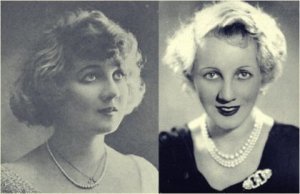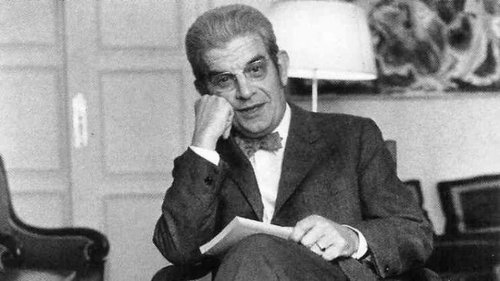The Case of Aimée or Self-Punishing Paranoia

The case of Aimée is one of the most famous cases in the psychiatric and psychoanalysis fields. This is due to two main reasons. The first is that it was the fundamental case that proved Jacques Lacan’s thesis. The second is that it represented a significant cornerstone in the study of paranoid psychosis.
Jacques Lacan is probably the most famous psychoanalyst after Sigmund Freud. His research represents a definitive advance for classic psychoanalysis. The case of Aimée was the study that made him a famous new and lucid thinker in that field.
The case of Aimée is also famous due to the controversy it caused because of how the treatment was carried out and how it was presented to the scientific community. It also made the headlines due to the consequences it had. Without a doubt, this was an exciting chapter in the history of mental health.
“The real is what resists symbolization absolutely.”
-Jacques Lacan-

Marguerite Pantaine, Lacan’s Aimée
Marguerite Pantaine went down in history as the “Aimée”. This was the name of one of the characters in one of the novels she wrote. It was also the name that Lacan gave her in his thesis. She was a Catholic woman born in a farmhouse in France who apparently started developing feelings of persecution at the age of 28.
This all started during her first pregnancy. She thought that some people wanted to hurt her and developed violent behavior. She had a miscarriage and convinced herself that her friend was responsible for it.
She got better, but she started feeling persecuted again during her second pregnancy. And so, she never allowed anyone to watch her son, Didier, during the first five months of his life.
Her persecutory delusions increased. Consequently, she was first admitted to a psychiatric hospital. After her release, she went to live alone in Paris. Then, she started thinking that a young actress, Huguette Duflos, was the person who wanted to harm her son.
She even wrote letters to the Prince of Wales regarding her suspicions. Finally, in April 1913, Marguerite attacked the young actress with a knife. She went to jail for this.
The interesting development of the case of Aimée
After evaluating her mental state, psychologists sent Marguerite to a mental hospital in Santa Ana. This is where Jacques Lacan treated her for a year and a half. Her symptoms disappeared from the moment she entered the hospital. This is what drove Lacan to conclude that she suffered from “self-punishing paranoia”.
In other words, being punished is what made her better. She suffered from an unaware guilt and, after her detainment, she no longer had the need for delusions.
The case of Aimée had a peculiar development and outcome. Her situation fascinated Jacques Lacan. In fact, the name he called her, “Aimée”, means “loved one” in French. It’s curious that he would call her that. He didn’t have a romantic relationship with her, but in her situation, he found a key to develop his thesis on psychosis.
Marguerite wrote novels that no one dared to publish. During her treatment, she gave her writings to Lacan, who never returned them. Ironically, she became famous due to Lacan’s studies.
From the beginning of her treatment, Margeritte said that some people wanted to steal her writings. She accused writer Pierre Binot of stealing her ideas.

An unexpected ending
According to Jacques Lacan, Marguerite’s cure came simply from her punishment for the attempted murder. Some of her delusions returned sometime later but they didn’t complicate her life by then. She never returned to the psychiatric hospital, which confirmed the Lacanian thesis.
What’s surprising about this story is that Marguerite’s son, Didier, became a psychoanalyst. In his autobiography, he indicated that his mother felt really lonely due to her condition. Not knowing that the famous case of Aimée was about his mother, he went to Lacan’s office for a psychoanalysis.

After his suspicion of the similarities of the case of Aimée with his mother, he figured out that “Aimée” and his mother were one and the same. He complained to Lacan for not telling him this.
Didier tried to recover his mother’s novels but didn’t accomplish it. This story has a nice outcome because although he never read what his mother wrote, he ended up becoming a writer.
The case of Aimée is one of the most famous cases in the psychiatric and psychoanalysis fields. This is due to two main reasons. The first is that it was the fundamental case that proved Jacques Lacan’s thesis. The second is that it represented a significant cornerstone in the study of paranoid psychosis.
Jacques Lacan is probably the most famous psychoanalyst after Sigmund Freud. His research represents a definitive advance for classic psychoanalysis. The case of Aimée was the study that made him a famous new and lucid thinker in that field.
The case of Aimée is also famous due to the controversy it caused because of how the treatment was carried out and how it was presented to the scientific community. It also made the headlines due to the consequences it had. Without a doubt, this was an exciting chapter in the history of mental health.
“The real is what resists symbolization absolutely.”
-Jacques Lacan-

Marguerite Pantaine, Lacan’s Aimée
Marguerite Pantaine went down in history as the “Aimée”. This was the name of one of the characters in one of the novels she wrote. It was also the name that Lacan gave her in his thesis. She was a Catholic woman born in a farmhouse in France who apparently started developing feelings of persecution at the age of 28.
This all started during her first pregnancy. She thought that some people wanted to hurt her and developed violent behavior. She had a miscarriage and convinced herself that her friend was responsible for it.
She got better, but she started feeling persecuted again during her second pregnancy. And so, she never allowed anyone to watch her son, Didier, during the first five months of his life.
Her persecutory delusions increased. Consequently, she was first admitted to a psychiatric hospital. After her release, she went to live alone in Paris. Then, she started thinking that a young actress, Huguette Duflos, was the person who wanted to harm her son.
She even wrote letters to the Prince of Wales regarding her suspicions. Finally, in April 1913, Marguerite attacked the young actress with a knife. She went to jail for this.
The interesting development of the case of Aimée
After evaluating her mental state, psychologists sent Marguerite to a mental hospital in Santa Ana. This is where Jacques Lacan treated her for a year and a half. Her symptoms disappeared from the moment she entered the hospital. This is what drove Lacan to conclude that she suffered from “self-punishing paranoia”.
In other words, being punished is what made her better. She suffered from an unaware guilt and, after her detainment, she no longer had the need for delusions.
The case of Aimée had a peculiar development and outcome. Her situation fascinated Jacques Lacan. In fact, the name he called her, “Aimée”, means “loved one” in French. It’s curious that he would call her that. He didn’t have a romantic relationship with her, but in her situation, he found a key to develop his thesis on psychosis.
Marguerite wrote novels that no one dared to publish. During her treatment, she gave her writings to Lacan, who never returned them. Ironically, she became famous due to Lacan’s studies.
From the beginning of her treatment, Margeritte said that some people wanted to steal her writings. She accused writer Pierre Binot of stealing her ideas.

An unexpected ending
According to Jacques Lacan, Marguerite’s cure came simply from her punishment for the attempted murder. Some of her delusions returned sometime later but they didn’t complicate her life by then. She never returned to the psychiatric hospital, which confirmed the Lacanian thesis.
What’s surprising about this story is that Marguerite’s son, Didier, became a psychoanalyst. In his autobiography, he indicated that his mother felt really lonely due to her condition. Not knowing that the famous case of Aimée was about his mother, he went to Lacan’s office for a psychoanalysis.

After his suspicion of the similarities of the case of Aimée with his mother, he figured out that “Aimée” and his mother were one and the same. He complained to Lacan for not telling him this.
Didier tried to recover his mother’s novels but didn’t accomplish it. This story has a nice outcome because although he never read what his mother wrote, he ended up becoming a writer.
All cited sources were thoroughly reviewed by our team to ensure their quality, reliability, currency, and validity. The bibliography of this article was considered reliable and of academic or scientific accuracy.
Muñoz, P. D. (2003). La categoría clínica “paranoia de autocastigo”: una aproximación al estudio de su vigencia en la actualidad. Investig. psicol, 8(3), 109-121.
This text is provided for informational purposes only and does not replace consultation with a professional. If in doubt, consult your specialist.







